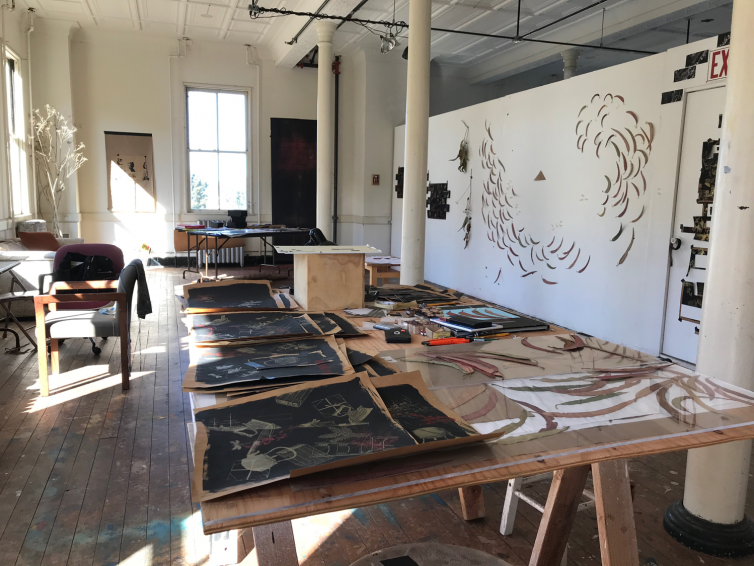In the Studio: Big Chief Tyrone “Pie” Stevenson
“When I sew, I'm sewing with all my ancestors, all the people that taught me thi...

New York artist Tomie Arai has served on the Foundation's Board of Directors since 2010. Due to new term limits for board members, Tomie stepped off the board at the end of 2019. We at the Foundation are deeply grateful for Tomie's contributions over these past nine years. Her insights as a practicing artist, her keen listening, and her probing questions have been invaluable to the evolution of the Foundation. She also helped shape the Foundation's Equity Committee, a group of staff and board who now meet regularly to consider how we can promote equity both internally and in our outward work.
In her last board meeting in early December, Tomie presented an artist talk for the Foundation's board and staff, focusing in particular on the importance that grants and residencies have played in her artistic development. In the spirit of honoring her service to the Foundation and sharing her work and personal story more widely, we offer the following overview of that presentation.
Tomie Arai first joined the Joan Mitchell Foundation community in 1994 as one of the inaugural recipients of the Foundation's annual Painters & Sculptors Grants. She was one of 22 artists in this first cohort of grantees, alongside Leonardo Drew, Melvin Edwards, and Howardena Pindell, to name a few. As Tomie said, "Each grant is a portal." Her grant was the beginning of a relationship that has grown and evolved over more than two decades.

The 1994 recipients of the Joan Mitchell Foundation Painters & Sculptors Grants
Aside from this grant, Tomie reflected on some of the opportunities to meet and work alongside other artists that served as benchmarks in her career, including residencies at the Robert Blackburn Printmaking Workshop, MacDowell Colony, Lower East Side Printshop, Self Help Graphics, Wave Hill, the Headlands Center for the Arts, and many other studios and residency centers.
“Workspaces are laboratories," she said. "They are spaces to plan, and make mistakes, and realize what you want to do.”

Tomie Arai working at the Lower East Side Printshop, 1996

Tomie Arai: Tales from Home, a featured artist exhibition at Center for Book Arts, New York, 2014

Tomie Arai with artwork created at Wave Hill, Bronx, NY, 2018

Tomie Arai's studio at Headlands Center for the Arts, 2019
Tomie also looked back on her work with collective groups like Godzilla: Asian American Arts Network, Chinatown Mural Workshop, and Chinatown Art Brigade, which she co-founded in 2015. She noted, "The Brigade is a way of establishing a sense of belonging amidst displacement.” With this collective work, she said, "I wanted to model a different kind of artistic production."

Chinatown Mural Workshop, 1977

Projection by Chinatown Art Brigade, 2016
Tomie showed photos of work produced in these communal spaces and collective groups, and shared a personal statement about her family's history that gives context to the recurring themes of immigration and displacement in her work:
"Every Asian family living in America has a migration story. As a third generation Japanese American, my story begins in Kyushu, Japan, the ancestral home of both of my parents. Pictured here is a photo of my grandparents, who met and married in San Francisco in 1913.

"My grandparents settled in Sacramento, raised six children, and ran a boarding house and restaurant called the OK Café that catered to itinerant Mexican and Japanese laborers. In 1942, Franklin D. Roosevelt’s signing of Executive Order 9066 authorized their forced incarceration at the Topaz Relocation Center, deep in the Utah desert, for the duration of World War II.
"After the war and the camps closed, dispersing families across the country, my parents met, married, and settled in New York, where I was born and raised. In post-war New York, Harlem was one of the few areas in the city where Japanese were welcomed and could find housing, and it became a temporary home for a large extended family uprooted by the internment. It was not long before a small enclave of Japanese Americans could be found living in Upper Manhattan. This recent portrait of my extended family sitting on a Harlem stoop in New York City reflects the global mix of cultures resulting from a century-long journey that has taken my family from Kumamoto to Harlem, from Kyushu, Toishan, Trinidad, and Mississippi to New York.

"My personal exploration of the immigrant experience emerged from a desire to acknowledge our uprootedness and give meaning to the spaces we live in. These migration stories helped me navigate a path through what cultural activist Roberto Bedoya refers to as ‘the politics of belonging and disbelonging.' ‘Before you have spaces of belonging,' he says, 'you must feel you belong.'”

Tomie Arai, An Album of Displacement (detail), 2019. Artist book, silkscreen, wood, hinges, 30” x 270”). Created at Headlands Center for the Arts.
In her contribution to the Foundation's Widening Circles publication in 2018, Tomie wrote, "My work with the Joan Mitchell Foundation has allowed me to reimagine a world in which cooperation and creativity across cultures, genders, borders, and race are valued and protected. By participating in the Foundation’s ongoing conversations about the need to build a more equitable and inclusive arts community, I’ve had the privilege of advocating for artists who truly reflect the diverse worlds in which we live."
You can follow Tomie Arai's work at tomiearai.com.